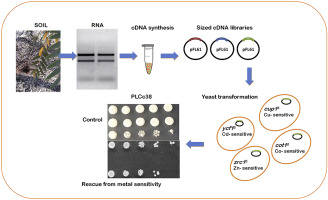Biochimie ( IF 3.9 ) Pub Date : 2019-03-21 , DOI: 10.1016/j.biochi.2019.03.010 Arkadeep Mukherjee , Rajiv Yadav , Roland Marmeisse , Laurence Fraissinet-Tachet , M. Sudhakara Reddy

|
Constant addition of heavy metal pollutants in soil resulting from anthropogenic activities can prove detrimental to both macro and micro life forms inhabiting the ecosystem. The potential functional roles of eukaryotic microbes in such environment were explored in this study by metatranscriptomics approach. Sized eukaryotic cDNA libraries, library A (<0.5 kb), library B (0.5–1.0 kb), and library C (>1 kb) were constructed from the soil RNA and screened for copper (Cu) tolerance genes by using copper sensitive yeast mutant strain cup1Δ. Screening of the cDNA libraries yielded different clones capable of growing in Cu amended medium. In the present investigation, one of the transcripts PLCc38 from the library C was characterized and tested for its ability to tolerate different heavy metals by using metal sensitive yeast mutants. Sequence analysis PLCc38 showed homology with aldehyde dehydrogenase (ALDH) and capable of tolerating high concentrations of Cu (150–1000 μM). Aldeyde dehydrogenases are stress response enzymes capable of eliminating toxic levels of aldehydes generated due to abiotic environmental stresses. The cDNA PLCc38 also provided tolerance to wide range of Cd (40–100 μM), Zn (10–13 mM) and Co (2–50 mM) concentrations. Oxidative stress tolerance potential of PLCc38 was also confirmed in presence of different concentrations of H2O2. This study proves that PLCc38 is a potent gene associated with metal tolerance which could be used to revegetate heavy metal polluted soil or as a biomarker for detection of metal contamination.
中文翻译:

运用转录组学方法从金属污染土壤中分离出重金属高耐受性真核醛脱氢酶
人为活动导致土壤中不断添加重金属污染物,这可能不利于生态系统中的宏观和微观生命形式。本研究通过超转录组学方法探讨了真核微生物在此类环境中的潜在功能。从土壤RNA构建大小的真核cDNA文库,文库A(<0.5 kb),文库B(0.5–1.0 kb)和文库C(> 1 kb),并使用铜敏感酵母筛选铜(Cu)耐性基因突变株CUP1 Δ。cDNA文库的筛选产生了能够在Cu改良培养基中生长的不同克隆。在本研究中,通过使用金属敏感的酵母突变体,对来自库C的转录本PLCc38之一进行了表征并测试了其耐受不同重金属的能力。序列分析PLCc38与醛脱氢酶(ALDH)具有同源性,并能够耐受高浓度的Cu(150–1000μM)。醛脱氢酶是能够消除由于非生物环境胁迫而产生的醛的毒性水平的胁迫响应酶。cDNA PLCc38还对宽范围的Cd(40-100μM),Zn(10-13 mM)和Co(2-50 mM)浓度提供了耐受性。在不同浓度的H 2存在下,也确认了PLCc38的耐氧化应激能力O 2。这项研究证明PLCc38是与金属耐受性相关的有效基因,可用于重新种植重金属污染的土壤或用作检测金属污染的生物标记。



























 京公网安备 11010802027423号
京公网安备 11010802027423号